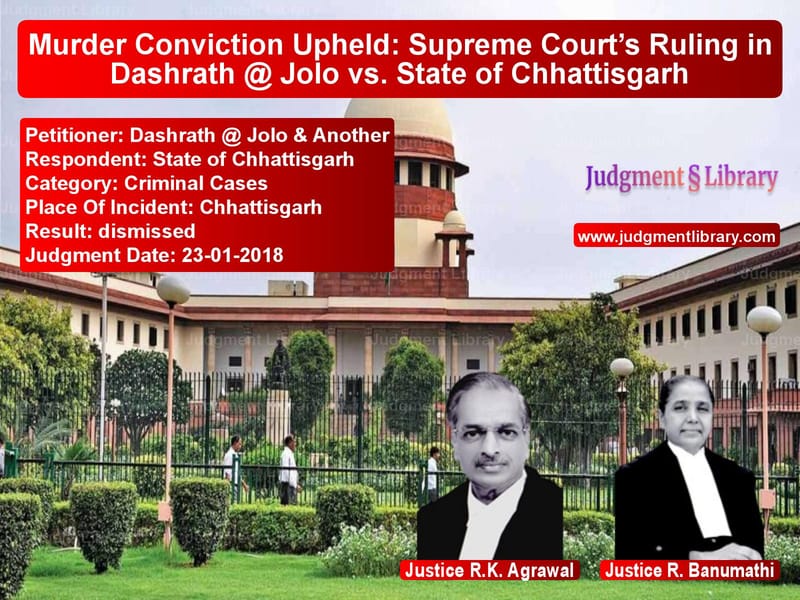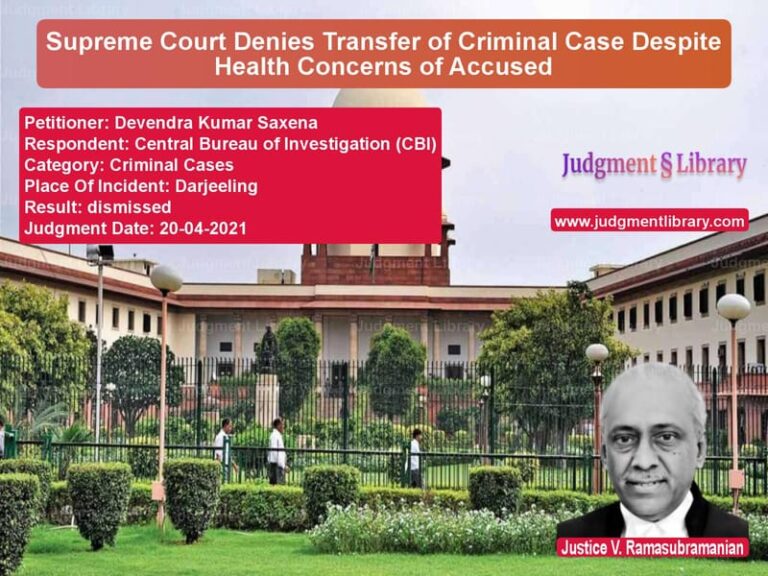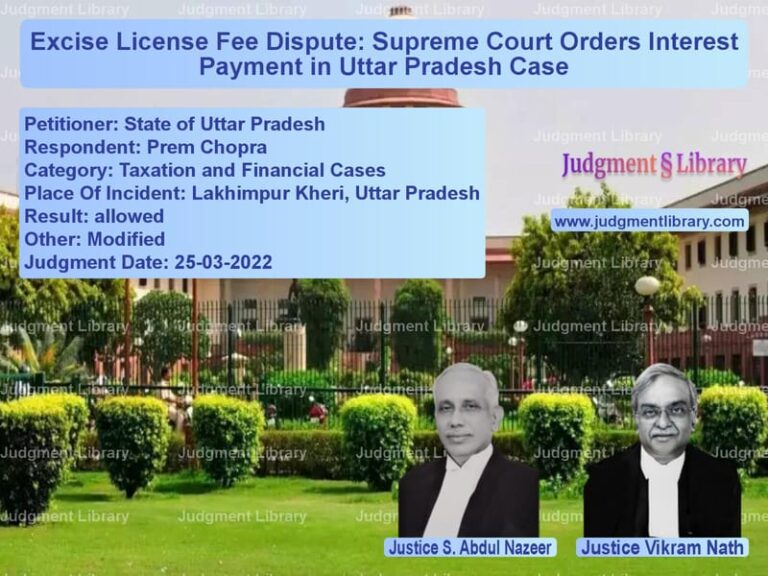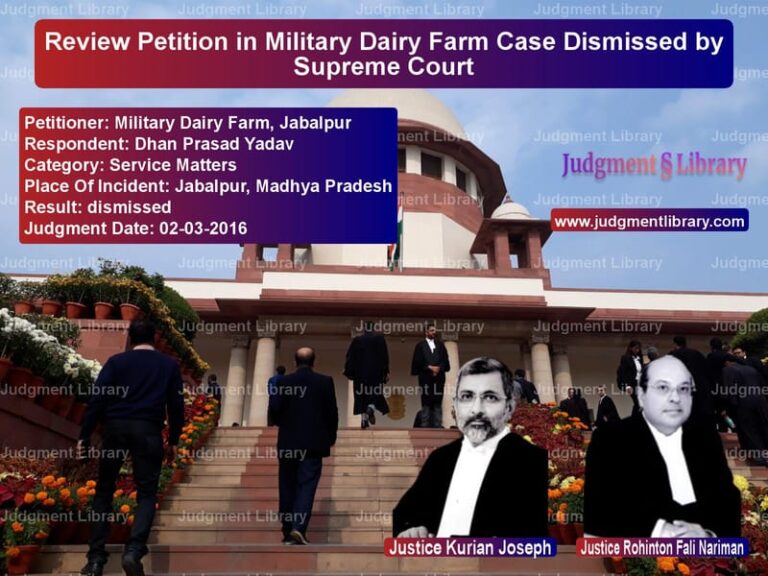Murder Conviction Upheld: Supreme Court’s Ruling in Dashrath @ Jolo vs. State of Chhattisgarh
The case of Dashrath @ Jolo & Another vs. State of Chhattisgarh is a significant ruling under the Indian Penal Code (IPC), 1860, particularly concerning unlawful assembly, murder, and self-defense claims. The Supreme Court examined whether the accused, who were convicted under Section 302 read with Section 149 IPC, were rightfully found guilty of forming an unlawful assembly with the intention to commit murder.
Background of the Case
The case originates from an incident on August 3, 2008, in the state of Chhattisgarh, where a violent altercation between neighbors resulted in the deaths of three individuals and injuries to others.
The key events:
- 1:30 p.m.: Complainant PW-19 Birichram went to invite his neighbor, Bhojram, to a child’s birth celebration.
- The appellants Dashrath @ Jolo and others, who lived near Bhojram, threatened to kill PW-19.
- When PW-19 objected, the appellants attacked him with battleaxes and sticks.
- As the assault continued, the deceased Chhedilal intervened, asking them to stop but was fatally attacked.
- Two more victims, Bhuru @ Parmanand and Bablu, were also killed when they tried to intervene.
- Injured witnesses PW-19 Birichram and PW-20 Dilip Kumar Yadav survived and later testified against the accused.
After an investigation, the police arrested the accused, seized weapons, and obtained an FSL report confirming the presence of blood on the weapons.
Key Legal Issues
- Whether the appellants formed an unlawful assembly with the intent to commit murder.
- Whether the appellants acted in self-defense as they claimed.
- Whether the conviction under Section 302 read with Section 149 IPC was justified.
- Whether the prosecution’s failure to explain injuries on the accused was fatal to their case.
Arguments by the Parties
Arguments by the Appellants (Dashrath @ Jolo & Others)
- The complainant party provoked the incident by creating a disturbance in front of their house.
- The appellants only acted in self-defense after being attacked first.
- The prosecution failed to explain the injuries sustained by the accused.
Arguments by the Respondent (State of Chhattisgarh)
- The appellants were the aggressors, and the victims were unarmed.
- Eyewitness testimonies, particularly from PW-19 Birichram, confirmed that the accused carried weapons and attacked without provocation.
- The presence of blood on the weapons and the forensic evidence corroborated the prosecution’s case.
Supreme Court’s Observations
On Unlawful Assembly and Common Object
- “The appellants, armed with battleaxes, kudari, and sticks, attacked the victims in a coordinated manner, proving that they acted with a common object.”
- “The prosecution’s evidence establishes that the accused formed an unlawful assembly with the intent to commit murder.”
On Self-Defense
- “The claim of self-defense is not substantiated, as the accused were the ones carrying weapons and initiating the attack.”
- “The victims were unarmed and merely trying to stop the attack on PW-19.”
On Non-Explanation of Accused’s Injuries
- “Non-explanation of injuries is not always fatal to the prosecution’s case.”
- “In this case, the injuries on the accused were minor and could have been self-inflicted.”
Supreme Court’s Final Judgment
The Supreme Court upheld the conviction of the appellants under Section 302 IPC read with Section 149 IPC. The key directives were:
- Life imprisonment for the appellants.
- Confirmation of the trial court’s and High Court’s findings.
- Rejection of the self-defense plea.
Legal Significance of the Judgment
This ruling establishes key legal principles:
- Unlawful Assembly and Common Object: The judgment reaffirms that coordinated attacks with weapons constitute unlawful assembly.
- Self-Defense Limitations: The ruling clarifies that self-defense must be supported by substantial evidence and cannot be claimed merely due to the presence of injuries on the accused.
- Prosecution’s Burden of Proof: The judgment states that non-explanation of minor injuries on the accused does not automatically weaken the prosecution’s case.
Conclusion
The Supreme Court’s decision in Dashrath @ Jolo vs. State of Chhattisgarh reinforces the law on murder and unlawful assembly. By upholding the convictions, the ruling ensures that individuals who form armed groups to commit violent acts cannot escape justice. This case serves as a precedent for similar murder trials involving multiple accused and common object offenses.
Don’t miss out on the full details! Download the complete judgment in PDF format below and gain valuable insights instantly!
Download Judgment: Dashrath @ Jolo & An vs State of Chhattisgar Supreme Court of India Judgment Dated 23-01-2018.pdf
Direct Downlaod Judgment: Direct downlaod this Judgment
See all petitions in Murder Cases
See all petitions in Attempt to Murder Cases
See all petitions in Judgment by R K Agrawal
See all petitions in Judgment by R. Banumathi
See all petitions in dismissed
See all petitions in supreme court of India judgments January 2018
See all petitions in 2018 judgments
See all posts in Criminal Cases Category
See all allowed petitions in Criminal Cases Category
See all Dismissed petitions in Criminal Cases Category
See all partially allowed petitions in Criminal Cases Category







